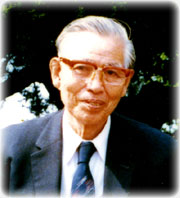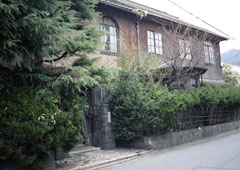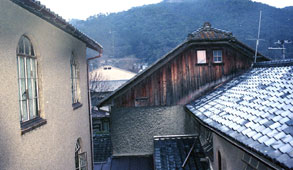創設者 濵中亦七氏について/Founder Mr. Matashichi Hamanaka

海の星学寮設立の経緯/Histry of Foundation
濵中亦七氏は18才の時、賀川豊彦氏が兵庫県西宮に開いていた聖書と社会奉仕の生活塾に入ってキリスト教と社会事業について半年間学びました。21才の時、カトリック宮津教会のルイ・ルラーブ神父に洗礼を授りました。
昭和24年頃巻網船団で得た配当金を私することをためらった濵中氏は、産業組合時代に京都府農業協同組合連合会顧問として種々教えて頂いていた京都大学名誉教授の橋本伝左衛門先生を京都市北白川のお宅に訪ね、配当金の扱いについて教えを乞われました。先生は、「今日迄農村の知性は地主階級によって支えられて来たが、土地解放により追放されたのでこれに替わる今後の農村の知性を養成するためには進学を容易にすることが重要である」との理由で、「人材育成の為に、学生寮を作れ」と教えられた。この教訓を素直に受入れ、具体的に実践して設立したのが財団法人海の星学寮です。
昭和26年(1951年)、京都市左京区浄土寺馬場町にあった四季荘という木造の寮を購入。放置されて痛みがひどい建物を改修し、寮母2人に住み込みを依頼して、20人の寮生に対して3食付きの学生寮として事業を開始しました。

 昭和62年(1987年)、再び濵中氏が私財を投じて、木造寮に代わる鉄筋コンクリート造、3階建、延790 m2の新棟を建築しました。現在は住み込みの寮母はいませんが、隣接する家屋に住む理事長とその夫人が常時世話をし、朝夕2食付きの寮として31人の学生が生活しています。
平成18年(2006年)濵中亦七氏死去に伴い、氏の長男濵中一徳氏が理事長に就任しました。
平成22年(2010年)理事・監事・評議員を新たに選出し、管理・運営体制を一新しました。
平成23年(2012年)に公益財団法人への移行を目指して、準備を進めました。
濵中氏がカトリック信者であったことからカトリック精神を本寮の基調としていますが、入寮者には創設の経緯とその精神について入寮時に説明するに止め、寮生活を通して自発的にその基礎にある奉仕の精神に思いを致してもらうこととしています。在寮中に、「隣人愛とヒューマニズムに根ざして普遍的な真理を追究し多元的な課題を解決すること」を学び、「共同生活を通じた全人格的な触れあいを経験することを通じて、わが国の文化の向上や社会発展に寄与する有為な人材として育つこと」を願っています。寮生の生活がこの寮の趣旨に沿ったものであるように、理事会に任命された寮長が指導しています。歴代寮長は、哲学者の国分敬治氏(元立命館大学教授、元南山大学教授)、教育学者の相良惟一氏(元京都大学教授、元聖心女子大学学長)、カトリック教会神父松田友明氏、であり、1984年からは化学者の船引卓三氏(元京都大学教授)が任に当たっています。
創立から65周年を迎えた海の星学寮からは、500人を超える卒寮生が巣立ち、国内外の各方面で幅広く活躍しています。
1987年に同窓会を設立し、同窓生の親睦と連携、寮の支援を目的とした活動をしてきましたが、2011年に寮生の指導・育成事業を支援することを重視する活動を展開することになりました。
この活動の一環として、9月と12月に海の星学寮懇話会、5月または6月頃に海の星学寮公開講演会が開催や、寮生の個別指導などに協力・支援いたします。
平成25年(2013年)3月22日に公益財団法人への移行が認可され、4月1日付けで公益財団法人海の星学寮として登記を完了し、新たな歩みを始めました。学生の社会トレーニングとしての寮生自治会事業や、OBの社会経験を伝える事業(懇話会と公開講演会)に加えて、新たに学生のメンタリング事業や学生の相互啓発発表会事業(互啓会)、国際交流事業を加えて、一層充実した育成プログラムを実施しております。
Mr. Matashichi Hamanaka was born in 1908 in a small fishing village at Kamanyu, Ine, where is located at the northern part of Tango Peninsula, Kyoto. He started his Christian life at 18 years old, when he learned about Bible and social service from Mr. Toyohiko Kagawa for a half a year in the Kagawa’s dormitory at Nishinomiya, Hyogo. At the age of 21, Mr. Hamanaka was baptized by a Catholic priest, Louis J. Relave at Miyazu Catholic Church. In 1949, when he was a leader of the fishermen’s cooperative at Kamanyu, he received a profit as an allotment of a successful round haul netter for a mackerel. Since he hesitated to use the profit for his private purpose, he asked Prof. Emeritus Denzaemon Hashimoto’s advice about the effective usage of the money. Mr. Hamanaka was acquainted with Prof. Hashimoto, Department of Agriculture, Kyoto University when Prof. Hashimoto served as an adviser of Kyoto Agricultural Cooperative Confederation. When Mr. Hamanaka visited Prof. Hashimoto at Kitashirakawa, Prof. Hashimoto recommended him to found a dormitory for students to nurture them to talented people on the following reason. Historically, the intelligence level in the country has been maintained by landed class people, but after the World War II the agrarian reform policy exiled these people from the country. In order to maintain the intelligence level in the country, it is important to make young people easy to learn in colleges and universities. Accepting this advice obediently, Mr. Hamanaka used the profit to found the Uninohoshi Gakuryo dormitory.
In 1951, Mr. Hamanaka bought a wooden building used as a dormitory named “Shiki-So” at Banba-cho, Jodo-ji, Sakyo-ku, Kyoto. Since the building was left without care and damaged, Mr. Hamanaka repaired and reformed for 20 students and 2 matrons (Ryobos) to live together. Ryobos served 3 meals in a day, which was very helpful for students in the poor period after the War. Since the wooden building needed continuous mending, Mr. Hamanaka donated a new building to the Foundation in place of the wooden building in 1987. 31 students became residents (Ryoseis) in the three-storied reinforced-concrete building of the total floor space, 790 m2. At present, in place of the resident Ryobos, Mr. Ichitoku Hamanaka and his wife as Ryobo live in the neighboring house and are taking care of students, serving 2 meals (breakfast and dinner) from Monday to Friday.
Since Hamanaka family is a Catholic, Catholicism is a basic spirit of Uminohoshi Gakuryo, as seen by the name of the dormitory, Uminohoshi (Maris Stella. i.e. Saint Maria), named by the founder. This will be explained to all Ryoseis before admission, but any religion including Catholic will not be insisted during the dormitory life. It is hoped, however, that Ryoseis will experience on their own initiative the Catholic and service spirits embodied by the founder, his family, and OB. Throughout the communal life which requires mutual contacts of total personalities, Ryoseis are expected to learn “importance of investigation of the universal truth and solution of plural subjects based on the charity and the humanism” and to grow into “talented people who will make remarkable contributions to not only progress and development of Japanese culture and society, but also global community in the different fields.
Dormitory superintendent (Ryocho), appointed by the chairman of the board of directors, serves as an advisor and an executor of the Uminohoshi program. Alumni members, ca.500, are willing to support the Uminohoshi program. As a proud tradition, all Ryoseis belong to a Ryosei council (Jichikai) and are requested to follow the Jichikai rules regulating communal life.
昭和62年(1987年)、再び濵中氏が私財を投じて、木造寮に代わる鉄筋コンクリート造、3階建、延790 m2の新棟を建築しました。現在は住み込みの寮母はいませんが、隣接する家屋に住む理事長とその夫人が常時世話をし、朝夕2食付きの寮として31人の学生が生活しています。
平成18年(2006年)濵中亦七氏死去に伴い、氏の長男濵中一徳氏が理事長に就任しました。
平成22年(2010年)理事・監事・評議員を新たに選出し、管理・運営体制を一新しました。
平成23年(2012年)に公益財団法人への移行を目指して、準備を進めました。
濵中氏がカトリック信者であったことからカトリック精神を本寮の基調としていますが、入寮者には創設の経緯とその精神について入寮時に説明するに止め、寮生活を通して自発的にその基礎にある奉仕の精神に思いを致してもらうこととしています。在寮中に、「隣人愛とヒューマニズムに根ざして普遍的な真理を追究し多元的な課題を解決すること」を学び、「共同生活を通じた全人格的な触れあいを経験することを通じて、わが国の文化の向上や社会発展に寄与する有為な人材として育つこと」を願っています。寮生の生活がこの寮の趣旨に沿ったものであるように、理事会に任命された寮長が指導しています。歴代寮長は、哲学者の国分敬治氏(元立命館大学教授、元南山大学教授)、教育学者の相良惟一氏(元京都大学教授、元聖心女子大学学長)、カトリック教会神父松田友明氏、であり、1984年からは化学者の船引卓三氏(元京都大学教授)が任に当たっています。
創立から65周年を迎えた海の星学寮からは、500人を超える卒寮生が巣立ち、国内外の各方面で幅広く活躍しています。
1987年に同窓会を設立し、同窓生の親睦と連携、寮の支援を目的とした活動をしてきましたが、2011年に寮生の指導・育成事業を支援することを重視する活動を展開することになりました。
この活動の一環として、9月と12月に海の星学寮懇話会、5月または6月頃に海の星学寮公開講演会が開催や、寮生の個別指導などに協力・支援いたします。
平成25年(2013年)3月22日に公益財団法人への移行が認可され、4月1日付けで公益財団法人海の星学寮として登記を完了し、新たな歩みを始めました。学生の社会トレーニングとしての寮生自治会事業や、OBの社会経験を伝える事業(懇話会と公開講演会)に加えて、新たに学生のメンタリング事業や学生の相互啓発発表会事業(互啓会)、国際交流事業を加えて、一層充実した育成プログラムを実施しております。
Mr. Matashichi Hamanaka was born in 1908 in a small fishing village at Kamanyu, Ine, where is located at the northern part of Tango Peninsula, Kyoto. He started his Christian life at 18 years old, when he learned about Bible and social service from Mr. Toyohiko Kagawa for a half a year in the Kagawa’s dormitory at Nishinomiya, Hyogo. At the age of 21, Mr. Hamanaka was baptized by a Catholic priest, Louis J. Relave at Miyazu Catholic Church. In 1949, when he was a leader of the fishermen’s cooperative at Kamanyu, he received a profit as an allotment of a successful round haul netter for a mackerel. Since he hesitated to use the profit for his private purpose, he asked Prof. Emeritus Denzaemon Hashimoto’s advice about the effective usage of the money. Mr. Hamanaka was acquainted with Prof. Hashimoto, Department of Agriculture, Kyoto University when Prof. Hashimoto served as an adviser of Kyoto Agricultural Cooperative Confederation. When Mr. Hamanaka visited Prof. Hashimoto at Kitashirakawa, Prof. Hashimoto recommended him to found a dormitory for students to nurture them to talented people on the following reason. Historically, the intelligence level in the country has been maintained by landed class people, but after the World War II the agrarian reform policy exiled these people from the country. In order to maintain the intelligence level in the country, it is important to make young people easy to learn in colleges and universities. Accepting this advice obediently, Mr. Hamanaka used the profit to found the Uninohoshi Gakuryo dormitory.
In 1951, Mr. Hamanaka bought a wooden building used as a dormitory named “Shiki-So” at Banba-cho, Jodo-ji, Sakyo-ku, Kyoto. Since the building was left without care and damaged, Mr. Hamanaka repaired and reformed for 20 students and 2 matrons (Ryobos) to live together. Ryobos served 3 meals in a day, which was very helpful for students in the poor period after the War. Since the wooden building needed continuous mending, Mr. Hamanaka donated a new building to the Foundation in place of the wooden building in 1987. 31 students became residents (Ryoseis) in the three-storied reinforced-concrete building of the total floor space, 790 m2. At present, in place of the resident Ryobos, Mr. Ichitoku Hamanaka and his wife as Ryobo live in the neighboring house and are taking care of students, serving 2 meals (breakfast and dinner) from Monday to Friday.
Since Hamanaka family is a Catholic, Catholicism is a basic spirit of Uminohoshi Gakuryo, as seen by the name of the dormitory, Uminohoshi (Maris Stella. i.e. Saint Maria), named by the founder. This will be explained to all Ryoseis before admission, but any religion including Catholic will not be insisted during the dormitory life. It is hoped, however, that Ryoseis will experience on their own initiative the Catholic and service spirits embodied by the founder, his family, and OB. Throughout the communal life which requires mutual contacts of total personalities, Ryoseis are expected to learn “importance of investigation of the universal truth and solution of plural subjects based on the charity and the humanism” and to grow into “talented people who will make remarkable contributions to not only progress and development of Japanese culture and society, but also global community in the different fields.
Dormitory superintendent (Ryocho), appointed by the chairman of the board of directors, serves as an advisor and an executor of the Uminohoshi program. Alumni members, ca.500, are willing to support the Uminohoshi program. As a proud tradition, all Ryoseis belong to a Ryosei council (Jichikai) and are requested to follow the Jichikai rules regulating communal life.

 昭和62年(1987年)、再び濵中氏が私財を投じて、木造寮に代わる鉄筋コンクリート造、3階建、延790 m2の新棟を建築しました。現在は住み込みの寮母はいませんが、隣接する家屋に住む理事長とその夫人が常時世話をし、朝夕2食付きの寮として31人の学生が生活しています。
平成18年(2006年)濵中亦七氏死去に伴い、氏の長男濵中一徳氏が理事長に就任しました。
平成22年(2010年)理事・監事・評議員を新たに選出し、管理・運営体制を一新しました。
平成23年(2012年)に公益財団法人への移行を目指して、準備を進めました。
濵中氏がカトリック信者であったことからカトリック精神を本寮の基調としていますが、入寮者には創設の経緯とその精神について入寮時に説明するに止め、寮生活を通して自発的にその基礎にある奉仕の精神に思いを致してもらうこととしています。在寮中に、「隣人愛とヒューマニズムに根ざして普遍的な真理を追究し多元的な課題を解決すること」を学び、「共同生活を通じた全人格的な触れあいを経験することを通じて、わが国の文化の向上や社会発展に寄与する有為な人材として育つこと」を願っています。寮生の生活がこの寮の趣旨に沿ったものであるように、理事会に任命された寮長が指導しています。歴代寮長は、哲学者の国分敬治氏(元立命館大学教授、元南山大学教授)、教育学者の相良惟一氏(元京都大学教授、元聖心女子大学学長)、カトリック教会神父松田友明氏、であり、1984年からは化学者の船引卓三氏(元京都大学教授)が任に当たっています。
創立から65周年を迎えた海の星学寮からは、500人を超える卒寮生が巣立ち、国内外の各方面で幅広く活躍しています。
1987年に同窓会を設立し、同窓生の親睦と連携、寮の支援を目的とした活動をしてきましたが、2011年に寮生の指導・育成事業を支援することを重視する活動を展開することになりました。
この活動の一環として、9月と12月に海の星学寮懇話会、5月または6月頃に海の星学寮公開講演会が開催や、寮生の個別指導などに協力・支援いたします。
平成25年(2013年)3月22日に公益財団法人への移行が認可され、4月1日付けで公益財団法人海の星学寮として登記を完了し、新たな歩みを始めました。学生の社会トレーニングとしての寮生自治会事業や、OBの社会経験を伝える事業(懇話会と公開講演会)に加えて、新たに学生のメンタリング事業や学生の相互啓発発表会事業(互啓会)、国際交流事業を加えて、一層充実した育成プログラムを実施しております。
Mr. Matashichi Hamanaka was born in 1908 in a small fishing village at Kamanyu, Ine, where is located at the northern part of Tango Peninsula, Kyoto. He started his Christian life at 18 years old, when he learned about Bible and social service from Mr. Toyohiko Kagawa for a half a year in the Kagawa’s dormitory at Nishinomiya, Hyogo. At the age of 21, Mr. Hamanaka was baptized by a Catholic priest, Louis J. Relave at Miyazu Catholic Church. In 1949, when he was a leader of the fishermen’s cooperative at Kamanyu, he received a profit as an allotment of a successful round haul netter for a mackerel. Since he hesitated to use the profit for his private purpose, he asked Prof. Emeritus Denzaemon Hashimoto’s advice about the effective usage of the money. Mr. Hamanaka was acquainted with Prof. Hashimoto, Department of Agriculture, Kyoto University when Prof. Hashimoto served as an adviser of Kyoto Agricultural Cooperative Confederation. When Mr. Hamanaka visited Prof. Hashimoto at Kitashirakawa, Prof. Hashimoto recommended him to found a dormitory for students to nurture them to talented people on the following reason. Historically, the intelligence level in the country has been maintained by landed class people, but after the World War II the agrarian reform policy exiled these people from the country. In order to maintain the intelligence level in the country, it is important to make young people easy to learn in colleges and universities. Accepting this advice obediently, Mr. Hamanaka used the profit to found the Uninohoshi Gakuryo dormitory.
In 1951, Mr. Hamanaka bought a wooden building used as a dormitory named “Shiki-So” at Banba-cho, Jodo-ji, Sakyo-ku, Kyoto. Since the building was left without care and damaged, Mr. Hamanaka repaired and reformed for 20 students and 2 matrons (Ryobos) to live together. Ryobos served 3 meals in a day, which was very helpful for students in the poor period after the War. Since the wooden building needed continuous mending, Mr. Hamanaka donated a new building to the Foundation in place of the wooden building in 1987. 31 students became residents (Ryoseis) in the three-storied reinforced-concrete building of the total floor space, 790 m2. At present, in place of the resident Ryobos, Mr. Ichitoku Hamanaka and his wife as Ryobo live in the neighboring house and are taking care of students, serving 2 meals (breakfast and dinner) from Monday to Friday.
Since Hamanaka family is a Catholic, Catholicism is a basic spirit of Uminohoshi Gakuryo, as seen by the name of the dormitory, Uminohoshi (Maris Stella. i.e. Saint Maria), named by the founder. This will be explained to all Ryoseis before admission, but any religion including Catholic will not be insisted during the dormitory life. It is hoped, however, that Ryoseis will experience on their own initiative the Catholic and service spirits embodied by the founder, his family, and OB. Throughout the communal life which requires mutual contacts of total personalities, Ryoseis are expected to learn “importance of investigation of the universal truth and solution of plural subjects based on the charity and the humanism” and to grow into “talented people who will make remarkable contributions to not only progress and development of Japanese culture and society, but also global community in the different fields.
Dormitory superintendent (Ryocho), appointed by the chairman of the board of directors, serves as an advisor and an executor of the Uminohoshi program. Alumni members, ca.500, are willing to support the Uminohoshi program. As a proud tradition, all Ryoseis belong to a Ryosei council (Jichikai) and are requested to follow the Jichikai rules regulating communal life.
昭和62年(1987年)、再び濵中氏が私財を投じて、木造寮に代わる鉄筋コンクリート造、3階建、延790 m2の新棟を建築しました。現在は住み込みの寮母はいませんが、隣接する家屋に住む理事長とその夫人が常時世話をし、朝夕2食付きの寮として31人の学生が生活しています。
平成18年(2006年)濵中亦七氏死去に伴い、氏の長男濵中一徳氏が理事長に就任しました。
平成22年(2010年)理事・監事・評議員を新たに選出し、管理・運営体制を一新しました。
平成23年(2012年)に公益財団法人への移行を目指して、準備を進めました。
濵中氏がカトリック信者であったことからカトリック精神を本寮の基調としていますが、入寮者には創設の経緯とその精神について入寮時に説明するに止め、寮生活を通して自発的にその基礎にある奉仕の精神に思いを致してもらうこととしています。在寮中に、「隣人愛とヒューマニズムに根ざして普遍的な真理を追究し多元的な課題を解決すること」を学び、「共同生活を通じた全人格的な触れあいを経験することを通じて、わが国の文化の向上や社会発展に寄与する有為な人材として育つこと」を願っています。寮生の生活がこの寮の趣旨に沿ったものであるように、理事会に任命された寮長が指導しています。歴代寮長は、哲学者の国分敬治氏(元立命館大学教授、元南山大学教授)、教育学者の相良惟一氏(元京都大学教授、元聖心女子大学学長)、カトリック教会神父松田友明氏、であり、1984年からは化学者の船引卓三氏(元京都大学教授)が任に当たっています。
創立から65周年を迎えた海の星学寮からは、500人を超える卒寮生が巣立ち、国内外の各方面で幅広く活躍しています。
1987年に同窓会を設立し、同窓生の親睦と連携、寮の支援を目的とした活動をしてきましたが、2011年に寮生の指導・育成事業を支援することを重視する活動を展開することになりました。
この活動の一環として、9月と12月に海の星学寮懇話会、5月または6月頃に海の星学寮公開講演会が開催や、寮生の個別指導などに協力・支援いたします。
平成25年(2013年)3月22日に公益財団法人への移行が認可され、4月1日付けで公益財団法人海の星学寮として登記を完了し、新たな歩みを始めました。学生の社会トレーニングとしての寮生自治会事業や、OBの社会経験を伝える事業(懇話会と公開講演会)に加えて、新たに学生のメンタリング事業や学生の相互啓発発表会事業(互啓会)、国際交流事業を加えて、一層充実した育成プログラムを実施しております。
Mr. Matashichi Hamanaka was born in 1908 in a small fishing village at Kamanyu, Ine, where is located at the northern part of Tango Peninsula, Kyoto. He started his Christian life at 18 years old, when he learned about Bible and social service from Mr. Toyohiko Kagawa for a half a year in the Kagawa’s dormitory at Nishinomiya, Hyogo. At the age of 21, Mr. Hamanaka was baptized by a Catholic priest, Louis J. Relave at Miyazu Catholic Church. In 1949, when he was a leader of the fishermen’s cooperative at Kamanyu, he received a profit as an allotment of a successful round haul netter for a mackerel. Since he hesitated to use the profit for his private purpose, he asked Prof. Emeritus Denzaemon Hashimoto’s advice about the effective usage of the money. Mr. Hamanaka was acquainted with Prof. Hashimoto, Department of Agriculture, Kyoto University when Prof. Hashimoto served as an adviser of Kyoto Agricultural Cooperative Confederation. When Mr. Hamanaka visited Prof. Hashimoto at Kitashirakawa, Prof. Hashimoto recommended him to found a dormitory for students to nurture them to talented people on the following reason. Historically, the intelligence level in the country has been maintained by landed class people, but after the World War II the agrarian reform policy exiled these people from the country. In order to maintain the intelligence level in the country, it is important to make young people easy to learn in colleges and universities. Accepting this advice obediently, Mr. Hamanaka used the profit to found the Uninohoshi Gakuryo dormitory.
In 1951, Mr. Hamanaka bought a wooden building used as a dormitory named “Shiki-So” at Banba-cho, Jodo-ji, Sakyo-ku, Kyoto. Since the building was left without care and damaged, Mr. Hamanaka repaired and reformed for 20 students and 2 matrons (Ryobos) to live together. Ryobos served 3 meals in a day, which was very helpful for students in the poor period after the War. Since the wooden building needed continuous mending, Mr. Hamanaka donated a new building to the Foundation in place of the wooden building in 1987. 31 students became residents (Ryoseis) in the three-storied reinforced-concrete building of the total floor space, 790 m2. At present, in place of the resident Ryobos, Mr. Ichitoku Hamanaka and his wife as Ryobo live in the neighboring house and are taking care of students, serving 2 meals (breakfast and dinner) from Monday to Friday.
Since Hamanaka family is a Catholic, Catholicism is a basic spirit of Uminohoshi Gakuryo, as seen by the name of the dormitory, Uminohoshi (Maris Stella. i.e. Saint Maria), named by the founder. This will be explained to all Ryoseis before admission, but any religion including Catholic will not be insisted during the dormitory life. It is hoped, however, that Ryoseis will experience on their own initiative the Catholic and service spirits embodied by the founder, his family, and OB. Throughout the communal life which requires mutual contacts of total personalities, Ryoseis are expected to learn “importance of investigation of the universal truth and solution of plural subjects based on the charity and the humanism” and to grow into “talented people who will make remarkable contributions to not only progress and development of Japanese culture and society, but also global community in the different fields.
Dormitory superintendent (Ryocho), appointed by the chairman of the board of directors, serves as an advisor and an executor of the Uminohoshi program. Alumni members, ca.500, are willing to support the Uminohoshi program. As a proud tradition, all Ryoseis belong to a Ryosei council (Jichikai) and are requested to follow the Jichikai rules regulating communal life.


